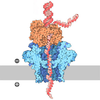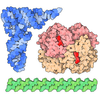+ Open data
Open data
- Basic information
Basic information
| Entry | Database: PDB / ID: 3bci | ||||||
|---|---|---|---|---|---|---|---|
| Title | Crystal Structure of Staphylococcus aureus DsbA | ||||||
 Components Components | Disulfide bond protein A | ||||||
 Keywords Keywords | OXIDOREDUCTASE / thiol-disulfide oxidoreductase / redox protein / protein folding / redox active centre | ||||||
| Function / homology |  Function and homology information Function and homology information | ||||||
| Biological species |  | ||||||
| Method |  X-RAY DIFFRACTION / X-RAY DIFFRACTION /  SYNCHROTRON / SYNCHROTRON /  MAD / Resolution: 1.81 Å MAD / Resolution: 1.81 Å | ||||||
 Authors Authors | Heras, B. / Thony-Meyer, L. / Martin, J.L. | ||||||
 Citation Citation |  Journal: J.Biol.Chem. / Year: 2008 Journal: J.Biol.Chem. / Year: 2008Title: Staphylococcus aureus DsbA Does Not Have a Destabilizing Disulfide: A NEW PARADIGM FOR BACTERIAL OXIDATIVE FOLDING Authors: Heras, B. / Kurz, M. / Jarrott, R. / Shouldice, S.R. / Frei, P. / Robin, G. / Cemazar, M. / Thony-Meyer, L. / Glockshuber, R. / Martin, J.L. #1: Journal: Acta Crystallogr.,Sect.F / Year: 2007 Title: Expression and crystallization of DsbA from Staphylococcus aureus Authors: Heras, B. / Kurz, M. / Jarrott, R. / Byriel, K.A. / Jones, A. / Thony-Meyer, L. / Martin, J.L. | ||||||
| History |
|
- Structure visualization
Structure visualization
| Structure viewer | Molecule:  Molmil Molmil Jmol/JSmol Jmol/JSmol |
|---|
- Downloads & links
Downloads & links
- Download
Download
| PDBx/mmCIF format |  3bci.cif.gz 3bci.cif.gz | 54.2 KB | Display |  PDBx/mmCIF format PDBx/mmCIF format |
|---|---|---|---|---|
| PDB format |  pdb3bci.ent.gz pdb3bci.ent.gz | 37.4 KB | Display |  PDB format PDB format |
| PDBx/mmJSON format |  3bci.json.gz 3bci.json.gz | Tree view |  PDBx/mmJSON format PDBx/mmJSON format | |
| Others |  Other downloads Other downloads |
-Validation report
| Summary document |  3bci_validation.pdf.gz 3bci_validation.pdf.gz | 419.1 KB | Display |  wwPDB validaton report wwPDB validaton report |
|---|---|---|---|---|
| Full document |  3bci_full_validation.pdf.gz 3bci_full_validation.pdf.gz | 420.3 KB | Display | |
| Data in XML |  3bci_validation.xml.gz 3bci_validation.xml.gz | 12.2 KB | Display | |
| Data in CIF |  3bci_validation.cif.gz 3bci_validation.cif.gz | 17 KB | Display | |
| Arichive directory |  https://data.pdbj.org/pub/pdb/validation_reports/bc/3bci https://data.pdbj.org/pub/pdb/validation_reports/bc/3bci ftp://data.pdbj.org/pub/pdb/validation_reports/bc/3bci ftp://data.pdbj.org/pub/pdb/validation_reports/bc/3bci | HTTPS FTP |
-Related structure data
- Links
Links
- Assembly
Assembly
| Deposited unit | 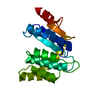
| ||||||||
|---|---|---|---|---|---|---|---|---|---|
| 1 |
| ||||||||
| Unit cell |
|
- Components
Components
| #1: Protein | Mass: 21809.979 Da / Num. of mol.: 1 / Fragment: residues in database 24-199 Source method: isolated from a genetically manipulated source Source: (gene. exp.)   |
|---|---|
| #2: Water | ChemComp-HOH / |
| Has protein modification | Y |
-Experimental details
-Experiment
| Experiment | Method:  X-RAY DIFFRACTION / Number of used crystals: 1 X-RAY DIFFRACTION / Number of used crystals: 1 |
|---|
- Sample preparation
Sample preparation
| Crystal | Density Matthews: 3.168319 Å3/Da / Density % sol: 65.49 % |
|---|---|
| Crystal grow | Temperature: 293 K / Method: vapor diffusion, sitting drop Details: 28-30% PEG 3350, VAPOR DIFFUSION, SITTING DROP, temperature 293K |
-Data collection
| Diffraction |
| |||||||||||||||||||||||||||||||||||||||||||||||||||||||||||||||||||||||||||||
|---|---|---|---|---|---|---|---|---|---|---|---|---|---|---|---|---|---|---|---|---|---|---|---|---|---|---|---|---|---|---|---|---|---|---|---|---|---|---|---|---|---|---|---|---|---|---|---|---|---|---|---|---|---|---|---|---|---|---|---|---|---|---|---|---|---|---|---|---|---|---|---|---|---|---|---|---|---|---|
| Diffraction source |
| |||||||||||||||||||||||||||||||||||||||||||||||||||||||||||||||||||||||||||||
| Detector |
| |||||||||||||||||||||||||||||||||||||||||||||||||||||||||||||||||||||||||||||
| Radiation |
| |||||||||||||||||||||||||||||||||||||||||||||||||||||||||||||||||||||||||||||
| Radiation wavelength |
| |||||||||||||||||||||||||||||||||||||||||||||||||||||||||||||||||||||||||||||
| Reflection | Redundancy: 8.2 % / Av σ(I) over netI: 10.5 / Number: 156671 / Rmerge(I) obs: 0.088 / Χ2: 0.87 / D res high: 1.99 Å / D res low: 50 Å / Num. obs: 19033 / % possible obs: 100 | |||||||||||||||||||||||||||||||||||||||||||||||||||||||||||||||||||||||||||||
| Diffraction reflection shell |
| |||||||||||||||||||||||||||||||||||||||||||||||||||||||||||||||||||||||||||||
| Reflection | Resolution: 1.8→37.06 Å / Num. all: 24921 / Num. obs: 24921 / % possible obs: 99.1 % / Observed criterion σ(F): 0 / Redundancy: 9.5 % / Biso Wilson estimate: 25.1 Å2 / Limit h max: 34 / Limit h min: 0 / Limit k max: 34 / Limit k min: 0 / Limit l max: 50 / Limit l min: 0 / Observed criterion F max: 460920.71 / Observed criterion F min: 2.97 / Rmerge(I) obs: 0.05 / Net I/σ(I): 21.9 | |||||||||||||||||||||||||||||||||||||||||||||||||||||||||||||||||||||||||||||
| Reflection shell | Resolution: 1.8→1.86 Å / Redundancy: 3.59 % / Rmerge(I) obs: 0.387 / Mean I/σ(I) obs: 3.3 / Num. unique all: 2272 / % possible all: 91.6 |
- Processing
Processing
| Software |
| ||||||||||||||||||||||||||||||||||||||||||||||||||||||||||||||||||||||||||||||||||||||||||
|---|---|---|---|---|---|---|---|---|---|---|---|---|---|---|---|---|---|---|---|---|---|---|---|---|---|---|---|---|---|---|---|---|---|---|---|---|---|---|---|---|---|---|---|---|---|---|---|---|---|---|---|---|---|---|---|---|---|---|---|---|---|---|---|---|---|---|---|---|---|---|---|---|---|---|---|---|---|---|---|---|---|---|---|---|---|---|---|---|---|---|---|
| Refinement | Method to determine structure:  MAD / Resolution: 1.81→29.57 Å / Rfactor Rfree error: 0.004 / Occupancy max: 1 / Occupancy min: 0.2 / Isotropic thermal model: anisotropic / Cross valid method: THROUGHOUT / σ(F): 0 / Stereochemistry target values: Engh & Huber MAD / Resolution: 1.81→29.57 Å / Rfactor Rfree error: 0.004 / Occupancy max: 1 / Occupancy min: 0.2 / Isotropic thermal model: anisotropic / Cross valid method: THROUGHOUT / σ(F): 0 / Stereochemistry target values: Engh & Huber
| ||||||||||||||||||||||||||||||||||||||||||||||||||||||||||||||||||||||||||||||||||||||||||
| Solvent computation | Solvent model: CNS bulk solvent model used / Bsol: 48.282 Å2 / ksol: 0.313641 e/Å3 | ||||||||||||||||||||||||||||||||||||||||||||||||||||||||||||||||||||||||||||||||||||||||||
| Displacement parameters | Biso max: 85.88 Å2 / Biso mean: 35.14 Å2 / Biso min: 16.26 Å2
| ||||||||||||||||||||||||||||||||||||||||||||||||||||||||||||||||||||||||||||||||||||||||||
| Refine analyze |
| ||||||||||||||||||||||||||||||||||||||||||||||||||||||||||||||||||||||||||||||||||||||||||
| Refinement step | Cycle: LAST / Resolution: 1.81→29.57 Å
| ||||||||||||||||||||||||||||||||||||||||||||||||||||||||||||||||||||||||||||||||||||||||||
| Refine LS restraints |
| ||||||||||||||||||||||||||||||||||||||||||||||||||||||||||||||||||||||||||||||||||||||||||
| LS refinement shell | Refine-ID: X-RAY DIFFRACTION
| ||||||||||||||||||||||||||||||||||||||||||||||||||||||||||||||||||||||||||||||||||||||||||
| Xplor file |
|
 Movie
Movie Controller
Controller





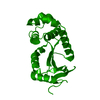




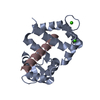
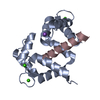

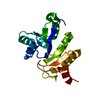

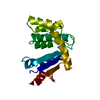

 PDBj
PDBj